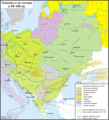Dosiero:Slav-7-8-obrez.png

Grandeco de ĉi antaŭvido: 544 × 599 rastrumeroj. Aliaj distingivoj: 218 × 240 rastrumeroj | 436 × 480 rastrumeroj | 698 × 768 rastrumeroj | 930 × 1 024 rastrumeroj | 1 860 × 2 048 rastrumeroj | 3 051 × 3 359 rastrumeroj.
Bildo en pli alta difino ((3 051 × 3 359 rastrumeroj, grandeco de dosiero: 339 KB, MIME-tipo: image/png))
Dosierhistorio
Alklaku iun daton kaj horon por vidi kiel la dosiero tiam aspektis.
| Dato/Horo | Bildeto | Grandecoj | Uzanto | Komento | |
|---|---|---|---|---|---|
| nun | 15:13, 12 aŭg. 2023 |  | 3 051 × 3 359 (339 KB) | Gyalu22 | Reverted to version as of 13:16, 23 October 2022 (UTC) Look at the atlas, don't do your own research |
| 17:43, 1 jun. 2023 |  | 3 051 × 3 359 (309 KB) | Shibbolet3579 | enice was still in the Byzantine Empire at this time. Avars were also present around Vienna and in central Transylvania, evidenced by graves & toponyms. There was a linguistic contact between Albanians and Vlachs, evidenced by the non-Slavic words present in both languages. Placed the Etelköz of the Magyars and the Crimean byzantine Greeks. South-Slavic toponyms (as Trnava for "tip, hillock, mound") evidenced a South-Slavic presence in southern Transylvania. Concerning the Eastern romance spe... | |
| 13:16, 23 okt. 2022 |  | 3 051 × 3 359 (339 KB) | Gyalu22 | Reverted bad faith edit, restored to version as of 26 July 2011. The Westermanns Atlas is an irrelevant source for the previous map, as only the Southern Carpathians are shown as possibly inhabited by the Wallachians. | |
| 15:09, 28 apr. 2014 |  | 3 051 × 3 359 (302 KB) | Spiridon Ion Cepleanu | Bulgarian kingdom & east-romance vlachs according with the universitary atlases of history and the Grosser Atlas zur Weltgeschichte, dir. Hans-Erich Stier, Westermann, 1985, ISBN 3-14-10-0919-8, pp. 50, 55-57, 61 & 64. | |
| 18:27, 26 jul. 2011 |  | 3 051 × 3 359 (339 KB) | Koryakov Yuri | The map's resolution is drastically decreased. Undo | |
| 04:53, 26 jul. 2011 |  | 544 × 599 (329 KB) | Spiridon Ion Cepleanu | On the original version of this map, the eastern romance language-spoken populations ("Vlachs" or "Volokhs") are draw only in a little area around Sredets (today Sofia), according with only one of the POVs, called "Röslerian" (since Eduard Robert Rösler | |
| 13:52, 10 mar. 2008 |  | 3 051 × 3 359 (339 KB) | Koryakov Yuri | {{Information |Description= |Source= self-made |Date=March 2008 |Author= Koryakov Yuri |other_versions= }} == Licensing == {{self|cc-by-sa-3.0}} Category:Maps of the history of Russia in Russian [[Category:Maps |
Dosiera uzado
La jenaj paĝoj ligas al ĉi tiu dosiero:
Suma uzado de la dosiero
La jenaj aliaj vikioj utiligas ĉi tiun dosieron:
- Uzado en ar.wikipedia.org
- Uzado en arz.wikipedia.org
- Uzado en azb.wikipedia.org
- Uzado en ba.wikipedia.org
- Uzado en be-tarask.wikipedia.org
- Uzado en be.wikipedia.org
- Uzado en bg.wikipedia.org
- Uzado en ce.wikipedia.org
- Uzado en cs.wikipedia.org
- Uzado en cv.wikipedia.org
- Uzado en da.wikipedia.org
- Uzado en de.wikipedia.org
- Uzado en en.wikipedia.org
Vidi plian ĝeneralan uzadon de ĉi tiu dosiero.

